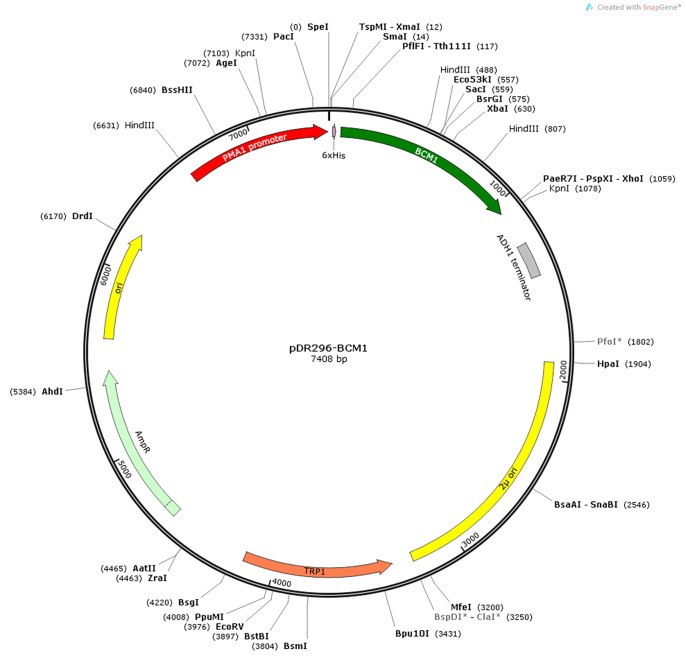Bcm1 (BALANCE OF CHLOROPHYLL METABOLISM 1) is a crucial transmembrane protein in plants, influencing chlorophyll levels. This protein plays a vital role in chlorophyll homeostasis during leaf development by stimulating chlorophyll biosynthesis and delaying its breakdown. This article details an optimized protocol for expressing and purifying His-tagged BCM1 from Saccharomyces cerevisiae (yeast) for biochemical and structural analyses. This method yields native BCM1 suitable for in vitro assays, such as studying its interaction with magnesium chelatase, the first enzyme in chlorophyll biosynthesis.
Introduction to BCM1 and Its Significance
Understanding the regulatory mechanisms of chlorophyll synthesis is critical for plant biology. BCM1, a recently discovered integral membrane protein in Arabidopsis thaliana, has emerged as a key player in this process. It interacts with and stimulates magnesium chelatase, the enzyme responsible for the initial step of chlorophyll production. Studying BCM1’s structure and function requires a reliable method for obtaining purified protein. This article describes a detailed protocol utilizing yeast for heterologous expression and purification of BCM1, a technique adaptable for similar multi-pass transmembrane proteins.
Why Yeast for BCM1 Expression?
Expressing membrane proteins like BCM1 presents significant challenges. While E. coli is commonly used for protein expression, it often produces misfolded and aggregated BCM1. Yeast, a eukaryotic organism, offers a more suitable environment for proper folding and membrane insertion of complex proteins. This yeast-based method provides a scalable, cost-effective alternative to cell-free or mammalian expression systems, yielding high quantities of functional BCM1.
Materials and Reagents for BCM1 Purification
The process requires standard laboratory equipment and reagents, including:
- Saccharomyces cerevisiae L40ccua strain and pDR296-His-BCM1 plasmid
- Culture media components: Bacto yeast extract, Bacto peptone, glucose, adenine sulfate, YNB, SD/-Trp
- Purification reagents: β-DM (n-dodecyl-β-D-maltoside), EDTA, Tris, protease inhibitors, Ni-NTA agarose resin, imidazole
- General lab supplies: pipettes, centrifuge tubes, filters, dialysis tubing, glass beads.
BCM1 Purification Protocol: A Step-by-Step Guide
- Yeast Transformation: The pDR296-His-BCM1 plasmid, carrying the BCM1 gene with a His-tag for purification, is introduced into the S. cerevisiae L40ccua strain. Figure 1 illustrates the plasmid map.
-
BCM1 Expression: Transformed yeast cells are cultured in SD/-Trp medium to selectively grow cells expressing the plasmid.
-
Cell Harvesting and Lysis: Yeast cells are harvested and lysed using glass beads to release the intracellular contents.
-
Membrane Protein Solubilization: BCM1, being a membrane protein, requires solubilization using a detergent, β-DM, to extract it from the cell membranes.
-
Nickel Affinity Chromatography: The His-tagged BCM1 is purified using Ni-NTA agarose resin, which binds specifically to the His-tag. Washing steps remove unbound proteins.
-
Elution and Dialysis: BCM1 is eluted from the resin using imidazole and then dialyzed to remove excess detergent and imidazole.
-
Verification: Successful BCM1 expression and purification are confirmed by SDS-PAGE and immunoblotting, as shown in Figures 2 and 3.
Conclusion: A Robust Method for BCM1 Purification
This protocol provides a detailed and effective method for the expression and purification of BCM1 from yeast. The purified BCM1 can be used in downstream applications like in vitro enzyme assays and structural studies, contributing to a deeper understanding of chlorophyll metabolism regulation. This method offers a valuable tool for researchers working with challenging transmembrane proteins. The resulting purified protein is suitable for crystallization studies, furthering our understanding of BCM1’s structure and its role in chlorophyll metabolism.

